Path analysis for jamovi
keywords pathj,jamovi, path analyis
PATHJ module of the PATHj suite for jamovi
PATHj version ≥ 0.2.* Draft version, mistakes may be around
Introduction
The PATHj module is a jamovi interface to lavaan R package
(Rosseel 2012). It implements path
analysis, so SEM models with observed variables (no latent variables).
The module handles continuous dependent (endogenous) variables,
continuous and categorical independent (exogenous) variables, linear and
interaction effects. Path diagrams are available thanks to R package
semPlot (Epskamp 2015). Please refer to these
packages help for details about models estimation, options, and path
diagrams features.
User Interface
To open PATHj, one clicks on the
SEM menu, and then Path Analysis under
pathj.
Like any jamovi module, the input user
interface resides on the left panel of the Analysis pane.
All options are in foldable panels, divided more or less by topic. The
only not foldable panel is the variable role definition panel, the one
at the top.
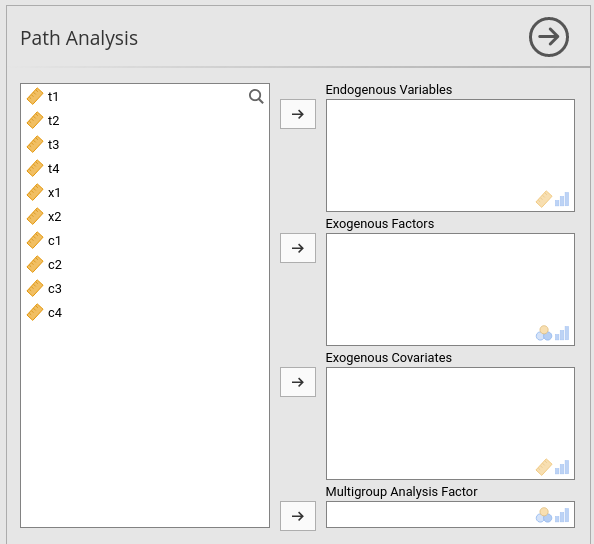
To run a model, we first select the variables and their role. `Endogenous Variables are the ones that will receive a path in the final model. Exogenous Variables are specified depending on their measurement level. Categorical exogenous variables go in Exogenous Factors, continuous variables in Exogenous Covariates.
Factors are handled by decomposing the variable in K-1 contrast variables and insert them in the model in place of the categorical variable. The type of contrast used, for each factor, can be seen and changed in the Factors Coding tab.
Continuous variables are left unchanged, but their scale can be changed in the Continuous Variables Scaling tab, for easily centering, or standardizing the variables.
Multigroup Analysis Factor is used to run multigroup analyses.
A model with two endogenous variables, one continuous and one factor as exogenous predictors is set as follows:
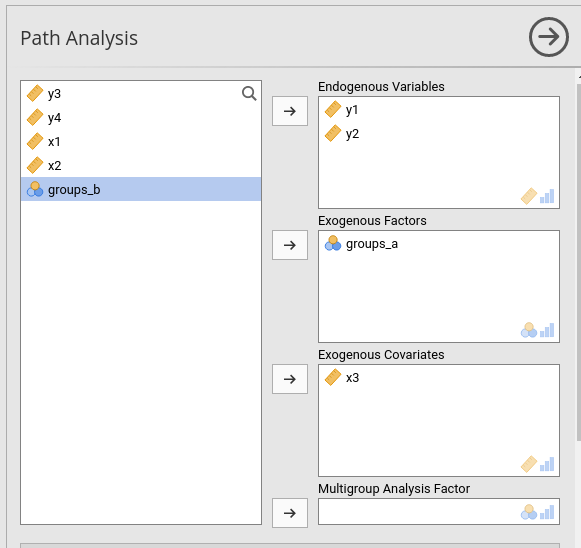
Endogenous Models
Here we specify the predictors of each endogenous variable. First we select on the right panel the endogenous model that needs to be set, then select the predictor(s) and fill the Models for Endogenous Vars field clicking the arrow. Interactions among predictors are included by selecting more then one term on the left, and bring them in the right panel with the arrow (see interactions in pathj for more info)
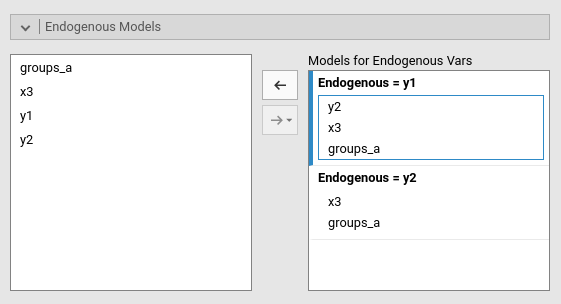
In this example, y1 is predicted by y2,
x3 and groups_a variables, whereas
y2 is predicted by x3 and
groups_a.
Variances and Covariances
By default, PATHj estimates the variances and the covariances among endogenous variables. More precisely, among variables that represent end-nodes of the path diagram. This behavior is controlled by the option Free Parameters -> Endogenous Correlations. If not selected, only the variances are estimated, and the covariances are set to 0.
The variances and covariances of the exogenous variables are computed from the sample data. In case one wants to estimate the population variances and covariances also for the exogenous variables, one should de-select the option Miscellaneous -> Fixed Exogenous in the Parameters Options panel, or select the terms pair in the left panel and bring it in the right panel.
Any variance or covariance not already present in the model can be
estimated by selecting the appropriate terms pair on the left panel and
bring it to the right panel. In this example, the estimation of the
variance of variable x3 is required.
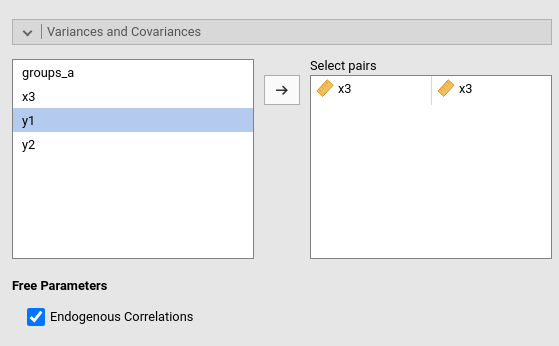
Model Options

Here we find some options regarding the estimation of the model as a whole. Estimation regards the estimator. At the moment, the following estimators are available, selected by Method combo-box:
- name: ML
title: Maximum Lik
- name: GLS
title: Generalized least squares
- name: WLS
title: Weighted LS
- name: DWLS
title: Diagonally weighted LS
- name: ULS
title: Unweighted LSAll explanations regarding the estimators can be found in the great lavaan documentation.
The option R-squared tests provides Chi-squared tests for the \(R2\). Details can be found here Computation details
Parameters Options
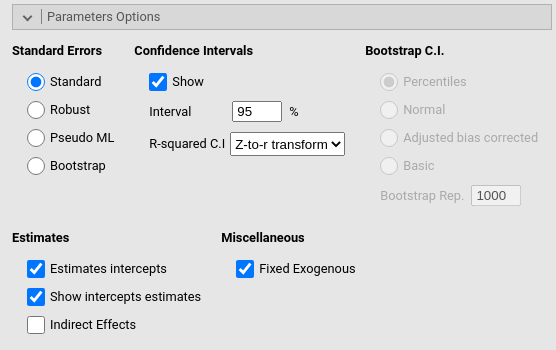
Here we find options regarding how to compute and display different
parameters. Standard errors decides the way
the standard errors of the parameters are computed. If
bootstrap is selected, the Bootstrap
C.I. options allow choosing the bootstrap method employed for the
confidence interval estimation. The alternatives are described in
lavaan help ?lavOptions.
R-squared C.I decides how to compute the R-squared confidence intervals. Details can be found in the Computation details.
Path Diagram
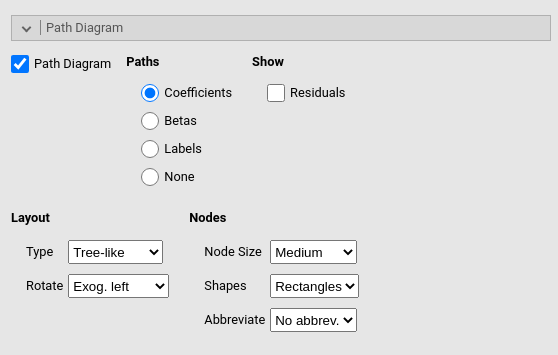
Here one asks for the path diagram. All options regard aestetics of the diagram. One can try out different options and see which diagram look suits better one’s tastes.
Custom Model Settings

This panel allows for additional lavaan syntax to be passed to the model definition. Its aim is to provide an easy mechanism to set user defined parameters, to free fixed coefficients, and to constrain parameters.
User defined parameters are combinations of parameters, such
as sums or products of coefficients. They are defined using the syntax
newlabel:= param_label1 operator param_label2, where
param_label is a coefficient label. PATHj assigns labels to coefficients
automatically, using p1, p2 etc.. One can
visualize them in the estimates tables by selecting Show parameters labels. newlabel is
optional. If not assigned, PATHj will
set it to dpX, where X is a counter of defined
parameters. The operator can be *
+ - and the like.
To free fixed parameters one indicates the parameter in lavaan syntax
style, in the form var1~~var2 or
var1~var2.
Parameters constraints are set using labels, in the form
p1==0 or p1==p2 and the like. The option Show examples outputs a table of most common
examples like the following table:
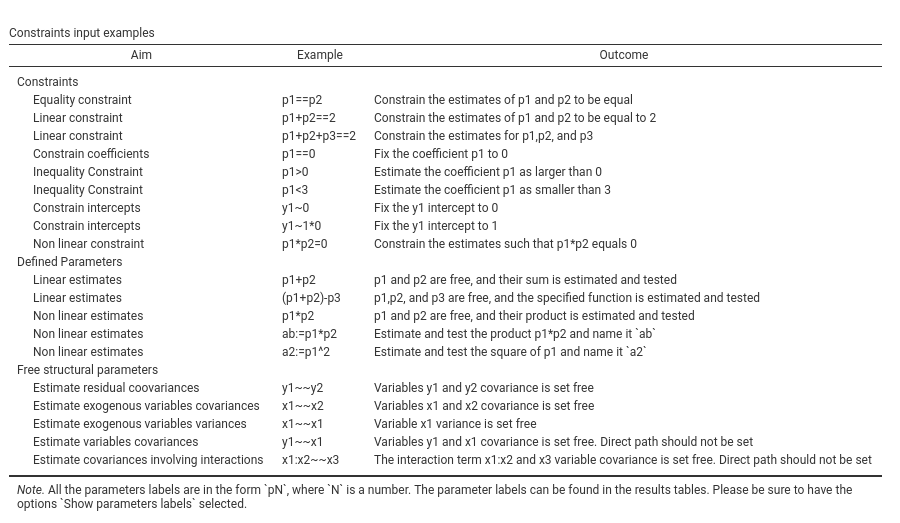
Options under Constraints tests controls the testing of the constraints statistical significance. Univariate produces a Chi-square test comparing the model with and without each individual constraint. Cumulative produces a Chi-square test for each model in which an additional constraint is added as compared with the original model without constraints.
Factors Coding
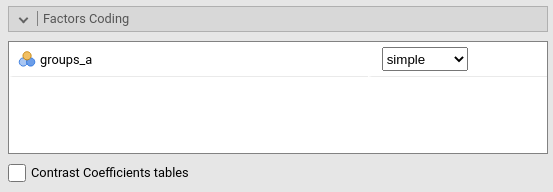
Categorical variables are cast into the model according to different coding systems. The coding system applies to all parameters estimates. The default coding system is simple, which is centered to zero and compares each mean with the reference category mean. The reference category is the first appearing in the variable levels.
Note that all contrasts but dummy guarantee to be centered to zero (intercept being the grand mean), so when involved in interactions, the other variables coefficients can be interpret as (main) average effects. If contrast dummy is set, the intercept and the effects of other variables in interactions are estimated for the first group of the categorical IV.
Contrasts variables are always named with the name of the factor and progressive numbers from 1 to K-1, where K is the number of levels of the factor.
Contrasts definitions can be seen in the output by selecting Contrasts coefficients table.
In reading the contrast definition table, one should interpret the
(1,2,3) code as meaning “the mean of the levels 1,2, and 3
pooled together”. If factor levels 1,2 and 3 are all levels of the
factor in the samples, (1,2,3) is equivalent to “the mean
of the sample”. For example, for a three levels factor, a contrast
labeled 1-(1,2,3) means that the contrast is comparing the
mean of level 1 against the mean of the sample. For the same factor, a
contrast labeled 1-(2,3) indicates a comparison between
level 1 mean and the subsequent levels means pooled together.
More details can be find in PATHj computation details and in GAMLj module help, which implements the same logic of contrasts.
Continuous Variables Scaling

Continuous variables, by default, are not changed in scale (none), but one can center them (centered), standardize them (z-scores), or log-transform (Log). Centering may be useful when interactions are involved in the model.
Examples
Some worked out examples of the analyses carried out with jamovi PATHj are posted here (more to come)
Details
Some more information about the module specs can be found here
Comments?
Got comments, issues or spotted a bug? Please open an issue on PATHj at github or send me an email